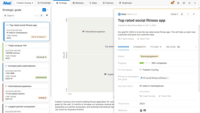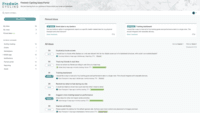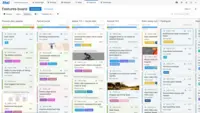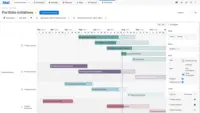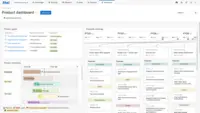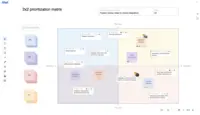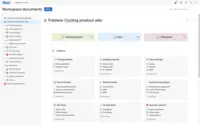Overview
What is Aha! Roadmaps?
Aha! Roadmaps is used to set strategy, prioritize features, and share visual plans. It includes Aha! Ideas Essentials for crowdsourcing feedback. For an integrated product development approach, Aha! Roadmaps and Aha! Develop can be used together. The software is available…
I won't manage a product without Aha!
Great way to manage and prioritize all things software related in one place
Love using this product
Aha! delivers on the promise of product roadmapping in agile software product management
Great play for the Product Management market
Aha! for all your roadmapping needs
Aha! has helping our product team thrive in 2020 and beyond!
Aha is the penultimate product planning tool
Excellent tool for small companies!
Aha! - One of the best Product Roadmapping software
Aha! - Strategy tracked how you need it
An excellent tool for realizing your strategic vision
Aha! is a great tool for high level strategic planning and idea bank management - not so much for day-to-day execution.
The kitchen sink of product management tools ... that needs a little work
Worth the learning curve
Pricing
Premium
$59
Enterprise
$99
Enterprise+
$149
Entry-level set up fee?
- Setup fee optional
Offerings
- Free Trial
- Free/Freemium Version
- Premium Consulting/Integration Services
Product Details
- About
- Integrations
- Competitors
- Tech Details
- FAQs
What is Aha! Roadmaps?
Aha! Roadmaps Features
- Supported: Goals can be set and linked through to key features, and the product roadmap.
- Supported: Each product feature can be assigned a product value score based on goals to prioritize what will deliver the most impact.
- Supported: Can be used to monitor progress status and communicate updates.
- Supported: Provides interactive roadmap presentations.
- Supported: Generates visualizations from entering data once.
- Supported: Captures feedback from customers, colleagues and partners via a custom-branded portal. Ideas and be ranked on value and effort, and promoted to the product roadmap.
- Supported: Plan visualizations displays the timing and scope of critical initiatives, launches, and projects, ensuring the capacity, deliverables, and dependencies can be seen across teams.
Aha! Roadmaps Screenshots
Aha! Roadmaps Integrations
Aha! Roadmaps Competitors
Aha! Roadmaps Technical Details
| Deployment Types | Software as a Service (SaaS), Cloud, or Web-Based |
|---|---|
| Operating Systems | Unspecified |
| Mobile Application | Apple iOS, Android |
Frequently Asked Questions
Comparisons
Compare with
Reviews and Ratings
(103)Community Insights
- Business Problems Solved
- Pros
- Cons
- Recommendations
Aha! Roadmaps is widely used by product management, engineering, and management teams for managing the product backlog and roadmap. The software's integration with other tools like Jira, Azure Dev Ops, Microsoft Teams, and Mavenlink project management enables seamless collaboration among different teams. Users appreciate the ideas portal feature in Aha! as it allows customers to enter and vote on ideas, guiding the development process to meet business needs effectively. With its ease of use in collecting and organizing features, Aha! simplifies the process for product managers, who find the learning curve for basic features quite straightforward.
The tool is particularly valued by product management teams for visualizing product roadmaps and managing dependencies efficiently. Its integration with Jira facilitates easy task tracking and updates, streamlining workflows for non-technical marketing teams. Aha! provides various helpful features such as visual orientation, internal linking capabilities, Gantt charts, and timeline mapping that aid in better planning and organization. By enabling users to track upcoming and current work across multiple teams within the entire organization, Aha! addresses the business problem of coordinating and managing efforts effectively. It allows product managers to associate each feature with its value to the organization and customers, setting it apart from other similar tools in the market. Additionally, Aha! serves as a platform for documenting product strategy, prioritizing initiatives, creating and tracking roadmaps, and communicating outcomes to engineering teams. IT and code-related functions also utilize Aha! to manage software releases, bug fixes, and ticket requests seamlessly.
Comprehensive Product Management Suite: Many users have found Aha! Roadmaps to be a comprehensive product management suite that excels in breaking down product plans into initiatives, features, and user stories. This feature helps the organization understand the product plan and the driving factors behind individual work items.
Effective Prioritization: Aha! stands out from project management tools like Jira by providing prioritization based on major themes, features, and releases. Users appreciate this feature as it allows them to organize and prioritize features effectively, making it difficult to go back to a traditional project management tool.
Idea Management Portal: Aha! is particularly useful for idea management. It offers a portal for users to submit ideas and manage them through a workflow. Some users appreciate that ideas can be submitted through various channels, including email, ZenDesk, and SalesForce. The ability to attach account values to ideas submitted through SalesForce is also appreciated.
Difficulty with Jira Mapping: Users have reported difficulties mapping products to projects in Jira, especially for engineering teams working on multiple products. This issue has been mentioned by several reviewers and affects the seamless integration between Aha! Roadmaps and Jira.
Overvalued Idea Management Feature: Some users feel that the idea management feature is overvalued and unnecessary for many companies, requiring a large product management team and excess development capacity. This sentiment has been expressed by multiple reviewers who believe that this feature adds complexity without providing significant value.
Missing Capacity Planning Feature: The lack of a robust capacity planning feature is considered a major drawback. Several reviewers have stated that the current capabilities are only half-functional, requiring manual entry and lacking easy feedback and progress tracking. This limitation hinders effective resource allocation and project planning within Aha! Roadmaps.
Based on user reviews, here are the three most common recommendations for the software:
-
It is important to have a strong governance process before implementing the software. Take the time to understand its functions and customize it to fit your business.
-
The software is a comprehensive tool for managing products throughout their lifecycle. Fully evaluate it before making a judgment on its usefulness. It can be particularly beneficial for commercial financing aids, sales communication progress, marketing project management, strategy adjustment, and goal setting.
-
Take advantage of integrations with other tools like Jira, but be prepared for some customizations not mapping perfectly. Make use of the free trial and support offered by the software. Be ready for a steep learning curve initially, as the software has many useful features like roadmaps and data analysis.
Overall, users recommend using this software to centralize product planning and roadmapping work, make informed decisions, keep stakeholders informed, and efficiently manage projects in an enterprise-level environment.
Attribute Ratings
Reviews
(1-19 of 19)I won't manage a product without Aha!
Mapping our work to value/strategy is a key differentiator between Aha! and other tools that we've evaluated or used in the past.
Love using this product
We have recently opened up the ideas portals and this has allowed us to present a simple way to interact with our customers, to allow them to enter, as well as vote on ideas for the product overall, to allow us to better guide the development organization towards building a product that meets business needs as opposed to simply keeping up with the Joneses on a feature by feature level.
Aha! delivers on the promise of product roadmapping in agile software product management
Great play for the Product Management market
If you need more advanced options it becomes a bit more tedious and complicated and you may require help, but Aha! has great support and sometimes contacted me without even asking for their help!
Aha! for all your roadmapping needs
The business problem it addresses is finding the best way to track project goals and timelines. With the fast pace environment we work in here, it's very helpful to have a tool that can best visualize your team's and individual progress on a project.
Aha is the penultimate product planning tool
Excellent tool for small companies!
Aha! - One of the best Product Roadmapping software
Aha! - Strategy tracked how you need it
An excellent tool for realizing your strategic vision
- To organize our thinking using best practices from our product organizations
- To separate the product planning work from engineering/construction work we do in JIRA.

